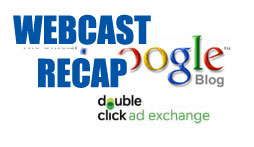 In today’s Google Investor Webcast, a team of Google execs focused on the company’s display advertising products including VP of Product Management, Neil Mohan, who addressed Google’s strategy for the Exchange.
In today’s Google Investor Webcast, a team of Google execs focused on the company’s display advertising products including VP of Product Management, Neil Mohan, who addressed Google’s strategy for the Exchange.
The on-demand version of the webcast (“December 15 Educational Webcast”) is available on Google’s IR site.
Mohan’s presentation was an abbreviated version of the same presentation he offered when the exchange launched last September – which is available here.
Also of note, Teracent popped up in the webcast as Google’s Ari Paparo said Teracent technology will be available through the Company’s ad serving system “in the coming months.”
YouTube and Google Content Network were also addressed before Mohan took back the mic and focused discussion back on the exchange saying Google was interested in “openness.” Yahoo! must love to hear this.
Mohan said “strong lifts in yield” are being realized on the exchange and the company hopes to provide some examples in the future.
From the Q&A portion of the webcast, some highlights:
- No plans for display ads to be targetable using paid search data. Google emphasized its sensitivity to privacy.
- On search engine result pages, Google’s Susan Wojcicki said that there are no plans for a single premium display ad (presumably standard IAB-size) as they’re focused on “the right experience” for the users and have recently rolled out new products in search such as Sitelinks.
- 1/5 of conversions are being derived from Google Content Network for the median advertiser (download white paper from earlier in the year here) at a CPA comparable to search. Text and graphical display ads were a part of this research.
- On the competition: No comment! But, Neil Mohan said it’s enthusiastic about the real-time aspects of the exchange and real-time bidding (RTB).
- Mobile display is a “large opportunity going forward” according to Google’s Wojcicki and said that she couldn’t comment on AdMob integration because the deal hasn’t closed yet.
- What’s bigger the mobile or video opportunity? Google says they’re both big!
- Mohan was not willing to break out on a percentage basis the AdSense and Dart For Publisher publisher inventory on the Exchange.
- Premium publishers are a part of the DoubleClick Ad Exchange according to Mohan and he said this inventory is both the premium and remnant inventory from these premium pubs.
- Agency demand-side platforms are welcomed by Google’s publishers according to Mohan.
AdExchanger.com also reached out with a couple of questions for the display team.
In regards to when Ad Sense publishers will see an appreciable lift from bidding by certified ad networks on their display placements, a Google spokesperson toed the line:
“Ad Exchange publishers have seen significant lift from both dynamic allocation and from the competition of many networks competing for inventory in real time. We’re working with publishers to make these figures public shortly.”
Another acronym you’ll be hearing more about in the future in regards to real-time bidding systems is QPS – known as “queries per second”. Put another way, this is the number of ad impressions that a bidding system can handle through it’s bidding “pipe,” if you will. The more impressions a bidder can see and decision on, the better – assuming you need scale which almost everyone does.
The Google spokesperson provided the following feedback when asked about current bidders and their QPS and data capabilities on the DoubleClick Ad Exchange saying:
“We’re ramping up with many bidders and ad networks that have a range of capabilities and scalability. Some companies are able to take the full QPS of the inventory we have available on the exchange while others are still in process of deploying the necessary infrastructure or selecting a sub-set of inventory that meets their needs.”
Room to grow!
We’re in the first inning and the count is full on the first batter.













